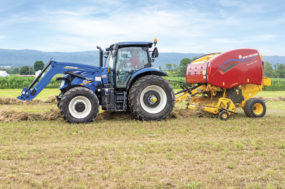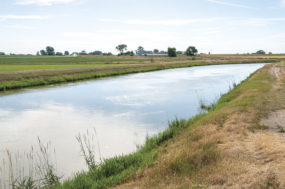He was driving a 1960 Ford 3/4-ton pick-up behind which he pulled a hoof-trimming trailer. The trailer rattled and clattered yet was sturdy enough to lift a Holstein cow (weighing 1,200 to 1,800 pounds) off her feet long enough for a toenail manicure.
A Fordson Major (English Ford farm tractor) four-cylinder diesel engine powered the Ford. The owner claimed to have purchased the truck from an auto transport with a full load of them on the way to Mexico.
The other claims he made were that the pick-up pulling his hoof trimming trailer averaged thirty miles per gallon, and that it had so much power it kept destroying the differential.
My wheels at the time were “Herman the German”, a 1959 Volkswagen beetle. The best I could coax out of it was an occasional 25 miles per gallon.To put that into perspective, my 1996 Lincoln Town Car gets 22 to 25 miles per gallon.
My son Dan, the 2nd generation professional hay hauler, runs a 1997 Freightliner truck with the Cat 3406E engine set at 550 horsepower.
Hauling baled hay stacked 14 feet high and running a gross weight of 102,000 pounds he averages 5.5 miles per gallon. My last hay truck was a 1973 Freightliner powered by a Cummins NTC 400 with an advertised horsepower of 400.
My combination was good for 96,000 pounds, also hauling baled hay stacked to 14 feet high. I averaged 5.2 miles per gallon. Dan’s truck is way more fun to drive.
My ’91 Dodge diesel pick-up would get an easy 21 miles per gallon on a trip. (Standard cab, two-wheel drive, standard transmission.)
My current baby, my 1997 Dodge BR3500 (standard cab, dual rear wheels, flat bed, four-wheel drive with a TCT #11 fuel plate that increases the stock power from 215 to 350 horsepower) will get over 18 miles per gallon on a trip. It will break the speed limit on any mountain pass towing my 1979 Avion 29 foot travel trailer.
Driving for mileage, I can get 12 to 14 miles per gallon towing the Avion. With all the tools and supplies I carry, the ’97 weighs about 8,500 pounds. The ’91 weighed in at 6,800 pounds.
For perspective, my 1971 Ford F-350 flat bed with the 390 gasoline engine and four-speed transmission averaged 11 to 12 miles to the gallon unloaded. As in the comparison between my 1973 truck and Dan’s 1997, twenty-five years of technology made quite an improvement in power and drivability with about a 9 percent increase in fuel mileage.
Diesel fuel contains more energy per gallon than does gasoline and even more per gallon than straight alcohol. The last time I drove across the Midwest I found that the ethanol-blend gasoline was rated at slightly higher octane than the straight gasoline, but it delivered a substantial decrease in fuel mileage. (1994 Ford Crown Victoria, straight gasoline, 25 to 28 miles per gallon, and 21 to 22 miles per gallon with the ethanol blend. Conservation and technology applied to traditional fuel sources can do only so much.
Bio-diesel is the current new game in town. I have never used it since it is not available yet in Royal City, WA. The claims for it are cleaner burning, more economical, from a renewable resource, etc. The claims against it are that it contains less energy per gallon than does straight diesel, may or may not shorten the life of the injector pump and may gel at a higher temperature than straight diesel.
With bio-diesel plants springing up like dandelions in spring it should soon be available in most markets. I intend to try it when it reaches my area. I do not intend to pay a premium for it.
The downside of bio-diesel is that the vegetable oils used to make it are also used for livestock feedstuffs and food products for human consumption. Note that Miracle Whip style salad dressing and cooking oils have doubled in price since the bio-diesel craze began.
Another alternative to energy dependence on foreign oil is diesel produced from the massive coal reserves this country is blessed to have. We have the technology to produce liquid fuel from coal that is clean, low in sulfur and in a supply that dwarfs the oil reserves of the Middle East. Why have we not done this before?
Because diesel fuel from coal needs a stable retail price of about $2.70 per gallon to be economically viable. We just might as well face it, the energy companies are going to keep on charging all they think they can get away with for gasoline and diesel.
It is not helpful when the governing bodies legislate rules for which the technology does not exist. It happened in the early 1970’s when unleaded gasoline became the law of the land.
Mopar had just begun to play with a little hot-rod engine known as the 340. It went away when unleaded gasoline and the lower compression ratios came in. The 340 set up for unleaded gas was said to have run slower than the previous year’s 318. The 340 was replaced quickly by the 360.
All the auto manufacturers went to larger engines to try to overcome the drop in performance caused by the lower compression ratios necessary to use the lower-octane fuel that had become the law of the land. The common cry was, “Tell me again how something that uses more fuel can create fewer emissions?”
The other complaints were that the catalytic converters created a stench like rotten egg gas, and that the new chariots would not move fast enough to get out of their own way.
Is there a cure for the mess we are in? Not as long as the powers that be are in a position to set off a wave of inflation by tripling the price of a necessity (fuel and heating oil) to eventually push us all into a higher tax bracket.
All to pay for things that “the most noble and wise among us,” as Ben Franklin described those we should elect to Congress, spent money we did not have.
This brings to mind the fellow who summoned to his deathbed his Senator and his Congressman, and asked them to stand on opposite sides of his bed.
When they asked why he had asked them to come, the old tycoon said that he thought it would be in order to die as his Savior had died, between two thieves.
The sad fact is we do not deserve any better government than we elect for ourselves. As we approach a presidential election are we doing our homework, with the hope to find an honest person among the contenders?
What to do? A smaller vehicle of any sort is out of the question for me. I am 6’4” tall and just barely fit in the Town Car. I had to install the air-ride driver’s seat from a heavy truck into my Dodge one-ton to make room for my long legs.
What we can do is to cheer on anyone who thinks he or she may have an idea to help lessen the energy crunch. Solutions that adversely affect our food and forage supply (the current ethanol and bio-diesel formulas) are not viable.
Can the capture of methane gas from livestock operations and landfills become viable? How about other biomass crops such as switchgrass? The claim is over 25 ton per acre and 80 gallons of ethanol per ton. Never heard of switchgrass? Nor had anyone heard of the Diesel engine 115 years ago.
Maybe Rudolph Diesel is not the hero of the invention of the Diesel engine after all. Perhaps it was the person who said to him, “Rudy, don’t let it bother you when these idiots call you a crackpot. You understand your idea, now get out there and make it work!” FG











